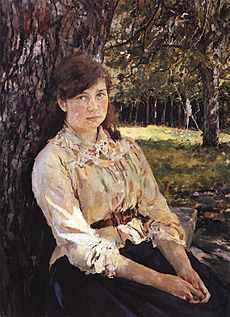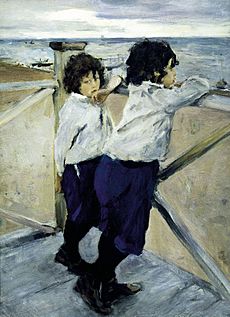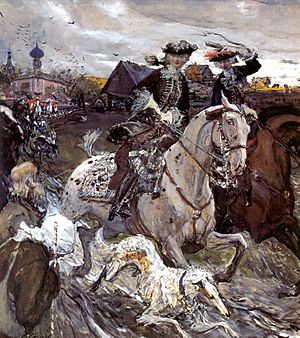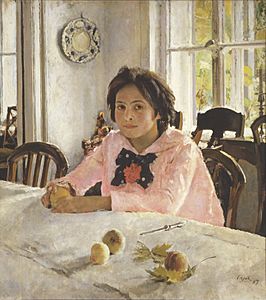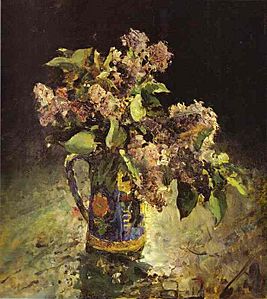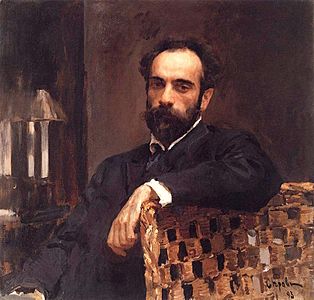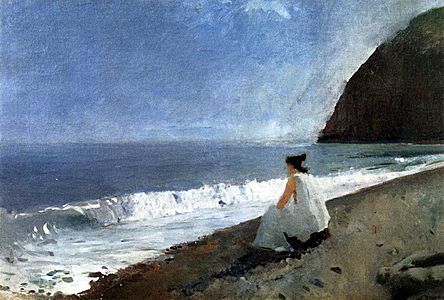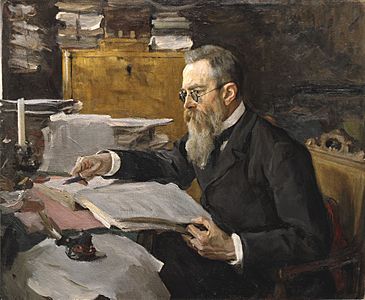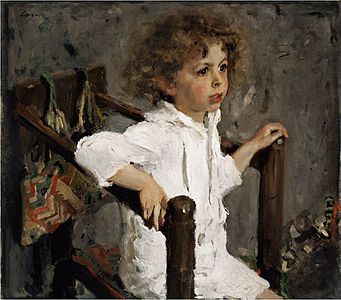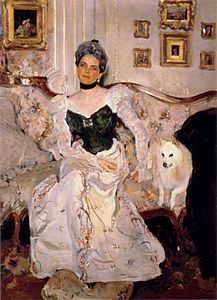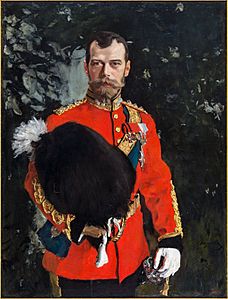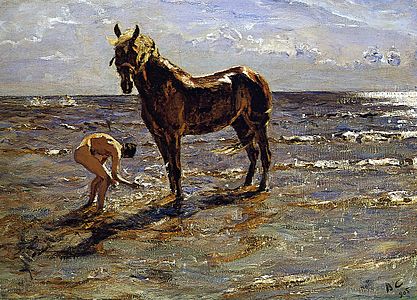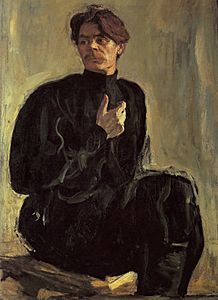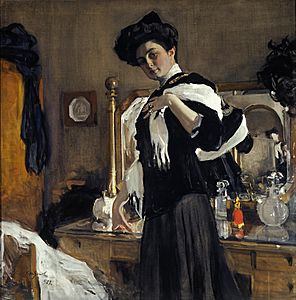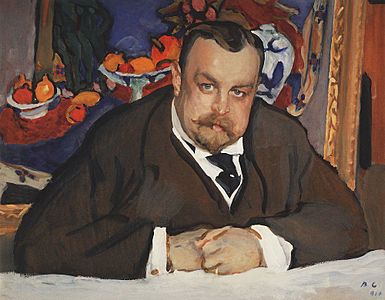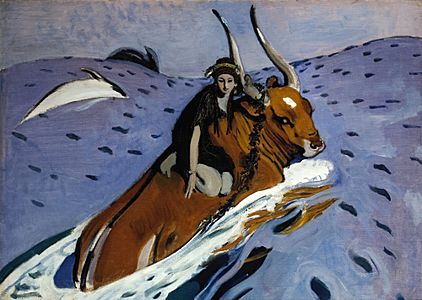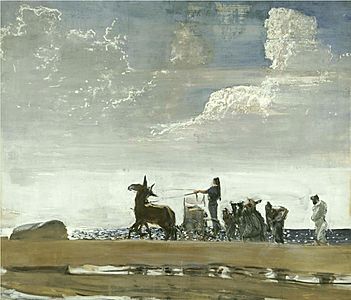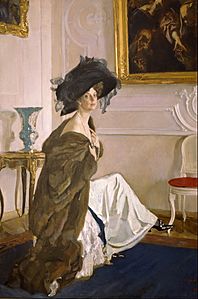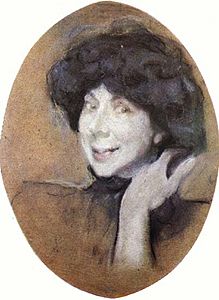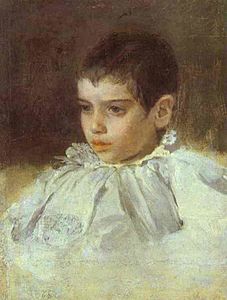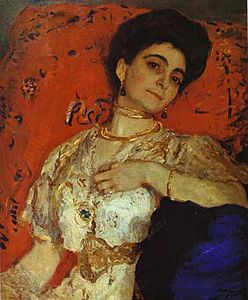Valentin Serov facts for kids
Quick facts for kids
Valentin Serov
|
|
|---|---|
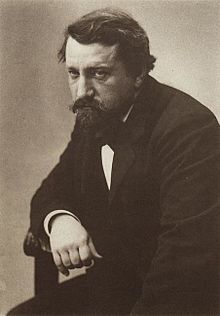
Valentin Serov, 1902
|
|
| Born |
Valentin Alexandrovich Serov
19 January 1865 |
| Died | 5 December 1911 (aged 46) Moscow, Russia
|
| Nationality | Russian |
| Education | Member Academy of Arts (1898) Full Member Academy of Arts (1903) |
| Alma mater | Imperial Academy of Arts |
| Known for | Portraits |
| Movement | Peredvizhniki, Impressionism, Mir iskusstva |
Valentin Alexandrovich Serov (Russian: Валенти́н Алекса́ндрович Серо́в; born January 19, 1865 – died December 5, 1911) was a famous Russian painter. He was one of the best portrait artists of his time.
Contents
Life and Work of Valentin Serov
Early Life and Art Education
Valentin Serov was born in Saint Petersburg. His father, Alexander Serov, was a composer and music critic. His mother, Valentina Serova, was also a composer. Growing up, Valentin was surrounded by art and music. His parents encouraged his artistic talents.
As a child, he studied art in Paris and Moscow. He learned from famous artists like Ilya Repin. Later, he attended the St. Petersburg Academy of Arts from 1880 to 1885. There, he studied under Pavel Chistyakov.
Serov's early art was inspired by the realistic style of Repin. He also learned a lot from Chistyakov's strict teaching methods. He was influenced by old master paintings he saw in museums. He also became friends with other artists like Mikhail Vrubel and Konstantin Korovin. The creative atmosphere at the Abramtsevo Colony, an art community, was also very important to him.
Serov's First Famous Paintings
Some of Serov's most famous early works were portraits. These include The Girl with Peaches (1887) and The Girl Covered by the Sun (1888). Both of these paintings are now in the Tretyakov Gallery in Moscow.
In these paintings, Serov focused on capturing the moment. He wanted to show how he saw the person and nature right then. He used light and color in a special way. This created a feeling of rich atmosphere. His fresh way of seeing the world showed signs of early Russian impressionism. This is a style where artists use small, thin brushstrokes to show light and movement. Interestingly, Serov didn't even know about French Impressionist painters when he made these works.
Becoming a Successful Portrait Artist
From 1890 onwards, portrait painting became Serov's main focus. His unique style became clear in this area. His portraits were known for showing the deep feelings and personalities of the people he painted. Serov loved to paint actors, artists, and writers. Some of his famous subjects include Konstantin Korovin (1891), Isaac Levitan (1893), Nikolai Leskov (1894), and Nikolai Rimsky-Korsakov (1898). All these paintings are in the Tretyakov Gallery.
At first, Serov often used darker colors like black, grey, or brown. He didn't use many bright colors like in the 1880s. Sometimes, he used Impressionistic ideas to show movement or how a portrait was put together. His Impressionism came from studying old masters like Frans Hals and Diego Velázquez, not just modern ideas.
Serov became very popular. In 1894, he joined a group called the Peredvizhniki, also known as "The Itinerants." These were artists who traveled to show their work. He received important requests to paint famous people. These included Grand Duke Pavel Alexandrovich (1897) and Felix Yusupov (1903). He also painted Princess Olga Orlova (1911). These paintings are known for their strong lines and beautiful color combinations.
At the same time, Serov also painted smaller, more personal portraits. He often painted children and women. In his portraits of children, he tried to capture their natural poses and movements. He wanted to show their honest and pure feelings. Examples include Children (1899) and Mika Morozov (1901). Serov also used different art techniques like watercolors, pastels, and lithographs. Over time, his figures became more detailed and simple, especially in his later works.
Serov's Family Life
Valentin Serov married Olga Trubnikova in 1889. His wife and their five children were often the subjects of his paintings. For example, his famous painting Children shows his sons, Yura and Sasha. His children's names were Olga, Alexander (Sacha), George (Yura), Michael, and Anton.
Later Artworks and Style Changes
After 1900, Serov joined "The World of art," an important Russian art group. At this time, his style began to change. The Impressionistic elements in his work faded. He developed a more modern style. However, he always kept his truthful and realistic way of understanding his subjects.
In the early 1900s, Serov created powerful portraits of important artists, writers, and musicians. These included Maxim Gorky (1904), Maria Yermolova (1905), and Feodor Chaliapin (1905).
Serov also showed his strong beliefs during the Revolution of 1905 to 1907. He drew satirical pictures that criticized those in power. He had been a full member of the St.Petersburg Academy of Arts since 1903. But in 1905, he resigned to protest against the killing of striking workers on Bloody Sunday.
In his later years, Serov also painted historical scenes. These included Peter II departure and Empress Elizabeth Petrovna on hunting (1900) and Peter I (1907). He also started painting themes from classical mythology. He gave these ancient stories his own unique touch.
Death
Valentin Serov passed away in Moscow on December 5, 1911. He died from a heart condition. He was first buried at the Donskoye Cemetery. Later, his remains were moved and reburied at the Novodevichy Cemetery.
Valentin Serov's Legacy
Serov's best works are considered some of the greatest examples of Russian realistic art. He taught at the Moscow School of Painting, Sculpture and Architecture from 1897 to 1909. Many famous artists were his students, including Pavel Kuznetsov, Martiros Saryan, and Kuzma Petrov-Vodkin.
In 2016, a special exhibition of Serov's work was held at the Tretyakov Gallery in Moscow. So many people wanted to see it that they waited for hours in the cold. After the Russian President Vladimir Putin visited, even more people came. The crowd was so large that one of the museum's doors broke! The Minister of Culture ordered the exhibition to stay open longer. They even set up a special food stand to give people waiting in line hot tea and porridge.
A small planet discovered in 1978 is named 3547 Serov after him.
Selected Artwork
-
The girl with peaches (1887) was the painting that started Russian Impressionism.
-
Portrait of Isaak Levitan (1893)
-
Portrait of Nikolai Rimsky-Korsakov (1898)
-
Portrait of Tsar Nicholas II (1902)
-
Portrait of Maxim Gorky (1905)
-
Portrait of Anna Benois wife of Alexandre Benois (1908)
See also
 In Spanish: Valentín Serov para niños
In Spanish: Valentín Serov para niños


